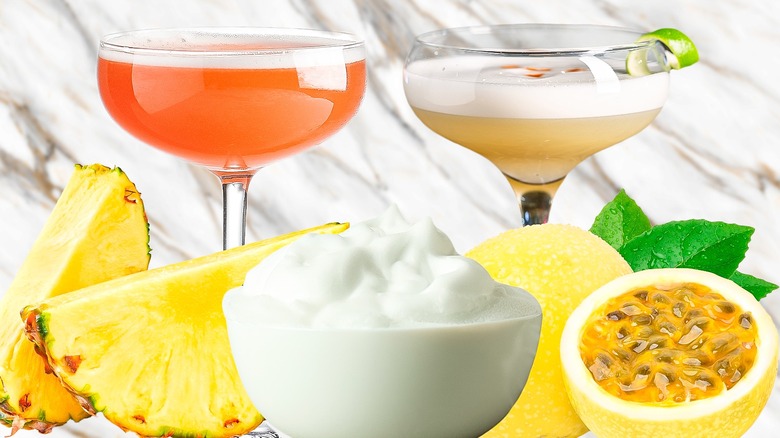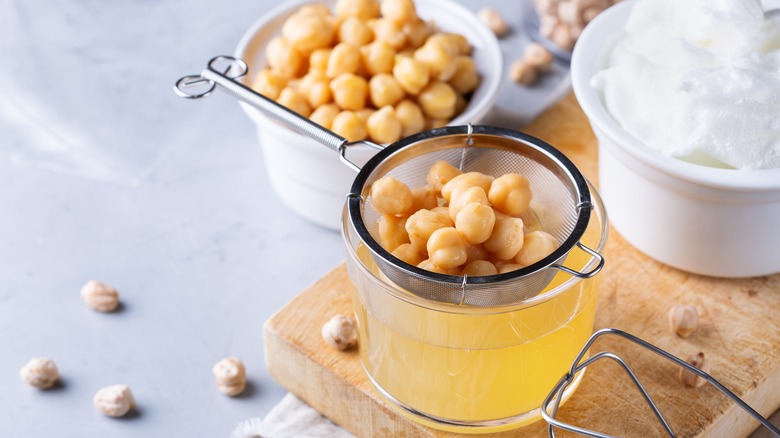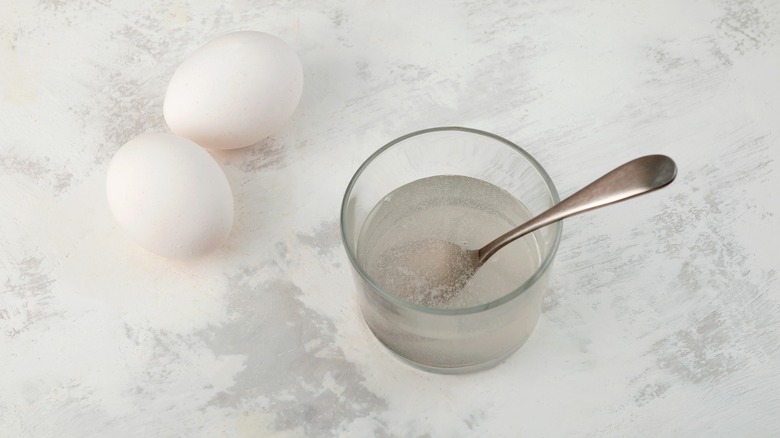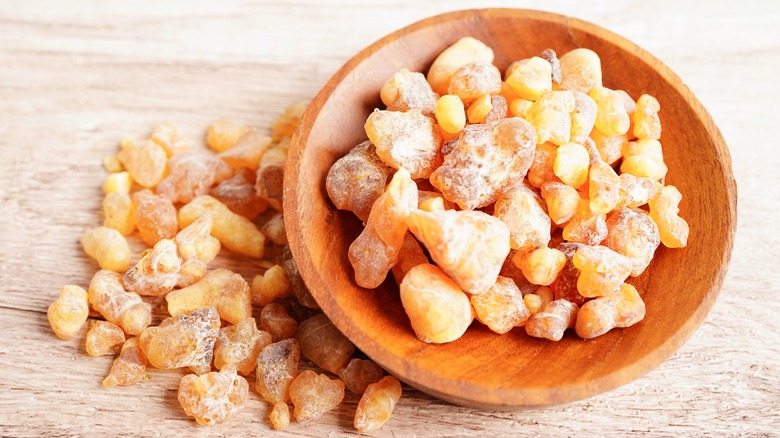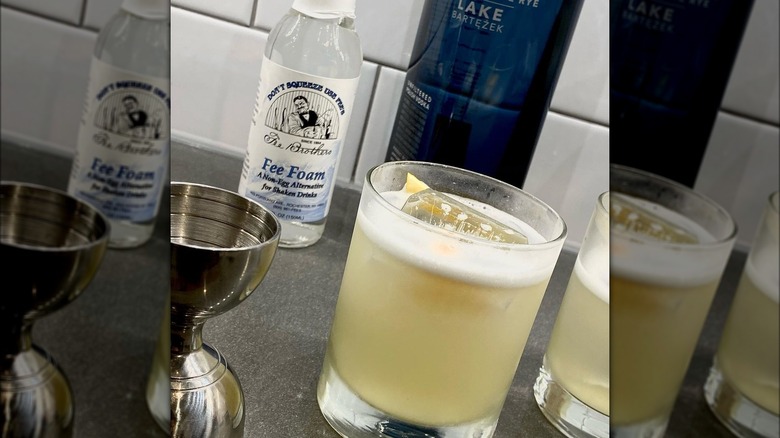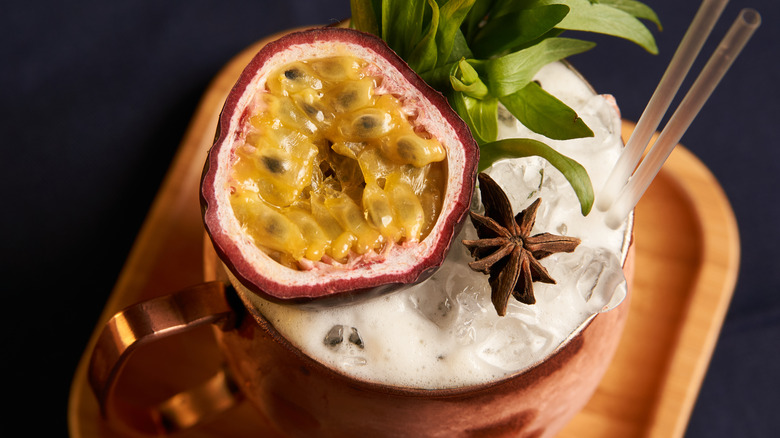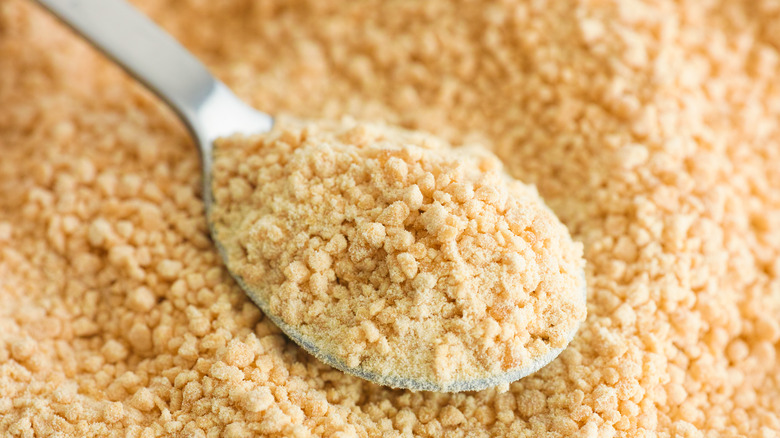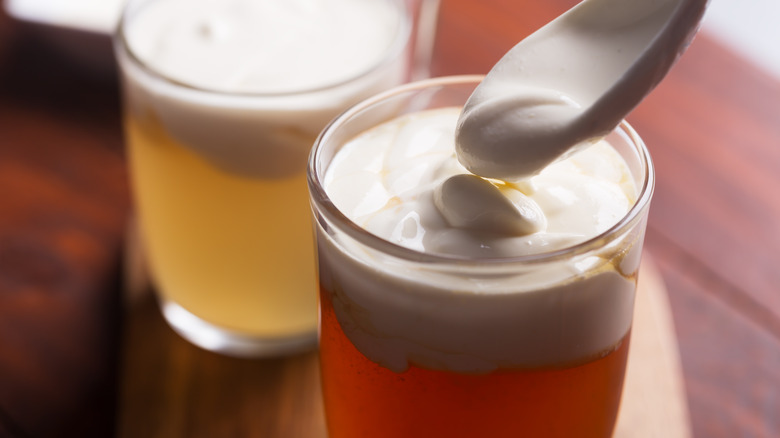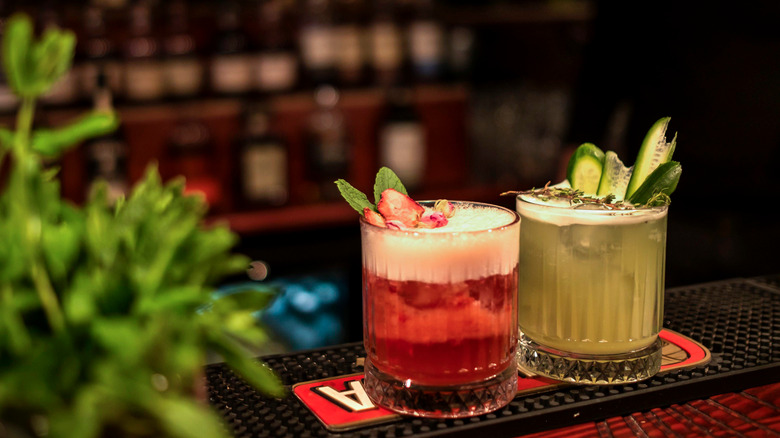7 Alternatives To Egg White Foams For Cocktails
If you've ever wondered why a seemingly furious bartender is thrashing their cocktail shaker around like they're in a tussle, there's a good chance they're trying to whip up a gorgeous, silky foam. What you might not realize is that in cocktails, foam actually serves a purpose. Classically, adding egg whites to a cocktail before giving it a rattle produces a luxurious crown of foam that adds a sense of panache while enhancing its aroma and texture.
These days, there are many reasons why adding egg whites to a drink doesn't appeal. Whether you are a vegan, have an allergy, worried about salmonella, or just think drinking raw egg is icky, there are effective substitutions to rescue your cocktail. Some are simple, while other methods require a little planning and preparation. Regardless, exploring alternatives to egg white foams can even help you beat wastage. After all, the white of an egg is only one part of it, and quite often, the remainder is destined for the trash. Besides, with all the hassle of making sure your eggs are safe to eat raw, who can be bothered?
I've worked as a bartender for many years, and have long held the position of delegated family cocktail chef. Having worked at the sharp end of the spirits industry as well as in spirits marketing, I know that reliable egg white substitutes are essential to the success of cocktail bars and home mixologists alike. More on how I chose these alternatives to egg white foams for cocktails is explained at the end of this article.
1. Aquafaba
1 tablespoon aquafaba = ½ ounce egg white
You know that slimy liquid at the bottom of a can of chickpeas? Well, this is actually a popular replacement for egg whites in baking, cooking, and even cocktails, called aquafaba. Aquafaba naturally repels water (hydrophobic) and simultaneously attracts it (hydrophilic). In non-science terms, this means that aquafaba at once binds to the air and the water in a liquid without letting these two elements combine, resulting in air suspended in and coated by liquid. In other words, foam.
Aquafaba is easy to use as an egg replacement, but it does come with some drawbacks. This can be a wasteful way to get hold of a cocktail foaming agent (unless you love eating large quantities of chickpeas). For some, the flavor of aquafaba is indetectable in a cocktail while others claim to still taste chickpeas when using it. Despite this drawback, aquafaba is popular as a vegan and dairy-free egg white substitute.
To use aquafaba, simply drain the water from a can of chickpeas and use it exactly as you would egg whites. For the best results, you can employ a dry shake method, shaking your combined liquids without ice, and then again with ice.
2. Hydrocolloids
½ ounce methylcellulose and xanthan solution = ½ ounce egg white
Hydrocolloids are a family of substances that thicken and emulsify liquids when in contact with water. Shaken or beaten, some can produce silky-smooth foams on cocktails and don't introduce unwanted flavors or aromas. The best hydrocolloids to use as an alternative to egg white foams for cocktails include xanthan gum, agar agar, guar gum, and methylcellulose. These are also very popular options for egg-weary vegans on the hunt for a tasty beverage. Hydrocolloids can often be found in powdered form, making them easy to use. Unlike aquafaba, which you can use immediately in place of egg white, hydrocolloids require additional steps to prepare, usually mixing the powders with water or even introducing heat.
Rather than use just one of these substances, creating a solution by combining them allows you to tweak your egg white substitute to get the exact consistency, density, and stability you desire. It's important to follow the packaging instructions carefully for hydrocolloids, as some take more effort to prepare, such as agar agar, which requires activation in boiling water. One of the most common solutions for an egg white substitute using hydrocolloids is a simple mix of methylcellulose and xanthan gum.
To create the solution, combine xanthan powder, methylcellulose powder, and water at a 1-10-500 ratio. Mix thoroughly with a blender on low speed and set the mixture in the fridge overnight.
3. Gum Arabic
½ ounce gum syrup = ½ ounce egg white (approximately)
Gum Arabic is a naturally occurring hydrocolloid, but it gets its own section because of its history and use. Gum Arabic is hardened sap collected from the acacia tree and is mixed with water and sugar to create a thickening egg-white substitute known as gum syrup (or gomme sirop in French if that's the language you prefer to parler).
Gum Arabic has almost no flavor and makes for a discreet yet effective cocktail foamer and viscosity booster. During the 1800s, syrup made with gum Arabic even used almonds for an additional layer of flavor, although this practice has fallen out of fashion. Today, gum Arabic comes in powder form, as many other hydrocolloids do, and is readily available for use behind the bar and in the kitchen. Alternatively, you can even purchase pre-made commercial gomme syrup made with gum Arabic.
To make the syrup at home, combine one ounce of gum Arabic with an equal portion of water and mix until completely dissolved (this may also require some waiting). Separately, stir together six ounces of caster sugar with two ounces of water in a saucepan to dissolve the sugar before mixing in the gum and water solution. Once combined, cool and bottle the syrup.
Use gum syrup the same way you'd use egg white in a cocktail shaker, but consider its sweetness as it simultaneously doubles as a simple syrup substitute. Adjust additional sweeteners or sugar accordingly.
4. Cocktail foaming products
2 dashes Fee Foam or 8-12 drops Miraculous Foamer = ½ ounce egg white
For those among us beginning to sweat over some of the more labor-intensive egg white substitutes, fear not. There are products on the market that are built for the very purpose of foaming up your cocktails without so much as a thought of an egg.
Products such as Fee Brothers' Fee Foam are flavor-neutral and colorless, and just two dashes are enough to replace the equivalent of half an ounce of egg white. Some who've used this product (and certainly the good people of Reddit) have found that Fee Foam isn't quite as effective or reliable as actual egg whites in creating satisfying foam. It is, however, a great vegan option and convenient to store and dispense.
Another popular vegan-friendly product is Ms. Better's Bitters Miraculous Foamer, which claims to contain the equivalent of 400 egg whites in every bottle. For the old one-two-punch, you can also use these commercial cocktail foamers in conjunction with other egg white alternatives such as gum syrup to enhance the level of foam you get.
Use Fee Foam exactly as you would egg white by adding a few dashes into a shaker before either dry shaking or shaking with ice. Alternatively, add Ms. Better's Bitters Miraculous Foamer with the pipette directly into the shaker with ice, as water actually helps to activate its foaming properties.
5. Fresh fruit pulp or juice
1 ounce passionfruit pulp or pineapple juice / 2 ounces crushed pineapple pieces = ½ ounce egg white
One of the most crucial elements of a classic frothy whiskey sour is the egg white foam, but the acidity of this cocktail makes it a great option for one of our fruitier substitutes. A fun way to add a punch of fruit flavor while performing the role of egg white is to use a high-protein fruit substitute, such as passion fruit pulp or pineapple.
The pulp or juice of these fruits creates a heady foam that's completely vegan and dairy-free while adding its distinctive tropical flavor to the drink and enhancing its overall texture. Fruit is also easy to use, without the need to process or prepare much ahead of time. Passionfruit pulp can go straight into the cocktail shaker, seeds and all, or throw in a handful of pineapple chunks after crushing them slightly. We'd recommend employing the dry shake first to give the foam its best chance before shaking the mixture again with ice. The critical step with this method is to double-strain with a fine cocktail strainer. This not only helps to filter out the seeds and other solids but also enhances the texture of the foam.
For even better results, blitz or blend your fruit before you use it to avail more proteins. In a pinch, even one ounce of pineapple juice by itself can help to add foam to your cocktail.
6. Soy lecithin
0.25%-0.5% (of liquid volume) soy lecithin powder = ½ ounce egg white
One of the vegan-friendly egg white substitutes that we borrow from the culinary world, soy lecithin, is a soybean-based phospholipid that can enhance the texture of liquids and emulsify ingredients that don't usually play together, such as water and oil. Just like aquafaba, soy lecithin creates a foam because of its simultaneously hydrophilic and hydrophobic properties.
Soy lecithin powder is easy to use, and a small amount in your shaker goes a long way to produce a stable, silky foam. A heavy hand can result in a bitter influence on the flavor of the cocktail, so it pays to carefully weigh or measure the amount you add to your cocktail.
Another popular method you can employ is to prepare the foam separately with water and an immersion or countertop blender before spooning, pouring, or piping it onto the cocktail. This can be a useful method if you want to create a foam with a different flavor makeup to the liquid of the drink for a multi-layered beverage.
For the simplest use with the most effective results, use a tiny amount of soy lecithin in the shaker proportional to the liquid and dry shake thoroughly for 20 seconds before shaking again with ice to chill. Pour once the shaker is frosted and serve immediately.
7. Versawhip
½ ounce Versawhip foam (2% Versawhip powder) = ½ ounce egg white
Soy has one more trick up its sleeve for whipping up foam for your cocktail ─ a molecular gastronomy foaming product called Versawhip. Molecular gastronomy may have surprising roots in the 15th century, but today it's influencing the cocktail game in real-time. Soy proteins help Versawhip to generate a decent foam, although its preparation means that it isn't a one-to-one replacement for egg whites in cocktails. Versawhip requires you to produce the foam independently with an immersion or countertop blender and lay it on your drink rather than working effectively as a foamer in a cocktail shaker. A foaming siphon also works to produce a smooth Versawhip foam.
Versawhip can tend to taste metallic or bitter to some. Adding sugar or sweetener to your foam can help to offset any unpleasant flavors from the Versawhip and create a more desirable addition to your cocktail. Alternatively, you can use fruit juice, cider, or wine as the liquid base to mask that Versawhip tang. This is one of Versawhip's major benefits, as it can work effectively with an acidic solution, offering more opportunities to experiment with flavors. Versawhip is also stable at a wide range of temperatures, which is handy when working with ice. Add Versawhip to a liquid of your choosing at about 2% of its volume, and blend thoroughly with an immersion or countertop blender until a firm and stable foam forms before spooning onto your cocktail.
Methodology
The strategy for compiling this list was to first identify the best substitutes for egg white that ideally can be used in the same way (shaken in a cocktail shaker), with the exception of Versawhip which is included because it's a popular gastronomical foaming technique that readers may be curious about trying on cocktails. The substitutions that made the final list were the ones most comparable in terms of preparation, use, and likeness regarding flavor and texture. In some cases, the egg white substitute needs to be prepared ahead of time through fairly technical means, but so long as you can use it the same way as you would an egg white when shaking a cocktail, it's a fair substitute.
I've tried a handful of these substitutions in the past, and have found pros and cons for each. For any I hadn't tried, I relied on research to find accounts of real-world applications, techniques, and reviews. Substitute quantities were calculated based on how much you'd need to replace ½ ounces of egg white to foam a single cocktail.
